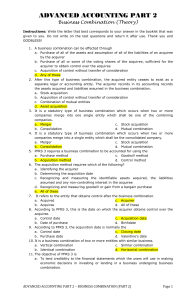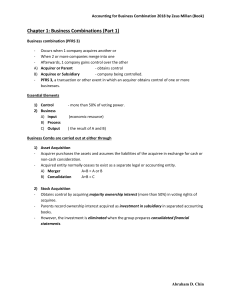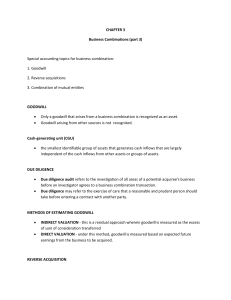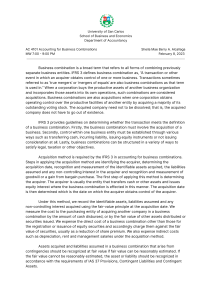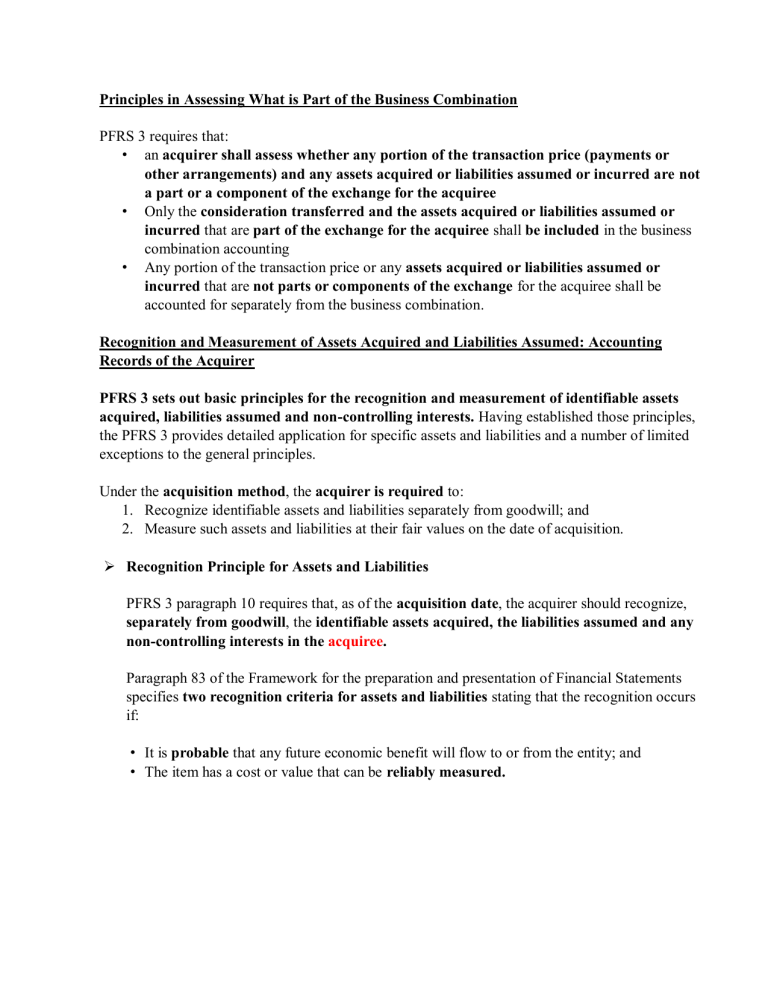
Principles in Assessing What is Part of the Business Combination PFRS 3 requires that: • an acquirer shall assess whether any portion of the transaction price (payments or other arrangements) and any assets acquired or liabilities assumed or incurred are not a part or a component of the exchange for the acquiree • Only the consideration transferred and the assets acquired or liabilities assumed or incurred that are part of the exchange for the acquiree shall be included in the business combination accounting • Any portion of the transaction price or any assets acquired or liabilities assumed or incurred that are not parts or components of the exchange for the acquiree shall be accounted for separately from the business combination. Recognition and Measurement of Assets Acquired and Liabilities Assumed: Accounting Records of the Acquirer PFRS 3 sets out basic principles for the recognition and measurement of identifiable assets acquired, liabilities assumed and non-controlling interests. Having established those principles, the PFRS 3 provides detailed application for specific assets and liabilities and a number of limited exceptions to the general principles. Under the acquisition method, the acquirer is required to: 1. Recognize identifiable assets and liabilities separately from goodwill; and 2. Measure such assets and liabilities at their fair values on the date of acquisition. Recognition Principle for Assets and Liabilities PFRS 3 paragraph 10 requires that, as of the acquisition date, the acquirer should recognize, separately from goodwill, the identifiable assets acquired, the liabilities assumed and any non-controlling interests in the acquiree. Paragraph 83 of the Framework for the preparation and presentation of Financial Statements specifies two recognition criteria for assets and liabilities stating that the recognition occurs if: • It is probable that any future economic benefit will flow to or from the entity; and • The item has a cost or value that can be reliably measured. Conditions for Recognition Principle In paragraphs 11 and 12 of PFRS 3, there are two conditions that have to be met prior to the recognition of assets and liabilities acquired in the business combination: 1. At the acquisition date, the assets and liabilities recognized by the acquirer must meet the definitions of assets and liabilities in the Framework. Any expected future costs cannot be included in the calculation of assets and liabilities acquired and liabilities assumed. The following are outcomes as a result of applying this recognition condition: • Post-acquisition reorganization • Unrecognized assets and liabilities As noted in Paragraph 13 of PFRS 3, a possible result of applying the principles of PFRS 3 is that there may be assets and liabilities recognized as a result of the business combination that were not recognized by the acquiree. One example of this is internally generated intangibles that were not recognized by the acquiree on the application of PAS 38 Intangible Assets; for example, internally generated brands would not be recognized by an acquire but would be recognized by the acquirer. The acquirer would measure these at fair value. 2. The item acquired or assumed must be part of the business acquired rather than the result of a separate transaction. Exception to the Recognition Principle One area affected by this condition is the accounting for contingent liabilities. PAS 37 Provisions, Contingent Liabilities and Contingent Assets. - This recognition principle is an example of the application of substance over form wherein the entities involved in the transactions may link another transaction with the business combination, but in substance it is a separate transaction. Measurement Principle for Assets and Liabilities Identifiable assets acquired and the liabilities assumed are measured at their fair values on acquisition date fair values. PFRS 13 (Fair Value Measurement) defines “fair value” as the price that would be received to sell an asset or paid to transfer a liability in an orderly transaction between market participants at the measurement date (i.e., an exit price). That definition of fair value emphasizes that fair value is a market-based measurement, not an entity-specific measurement. Fair value is basically a market-based measure in a transaction between unrelated parties. However, the process of determining fair value necessarily involves judgment and estimation. The acquiring entity is not actually trading the items in the marketplace for cash, but is trying to estimate what the exchange price would be if it did so. Hence, the determination of fair value involves estimation. To assist in the determination of fair value, the standard setters have developed a fair value hierarchy. The hierarchy categorizes the inputs used in valuation techniques into three levels. The hierarchy gives the highest priority to (unadjusted) quoted prices in active markets for identical assets or liabilities and the lowest priority to unobservable inputs. Measurement under the fair value hierarchy is as follows (it should be noted that inputs are being prioritized): • Level 1 Inputs – are fully observable and are unadjusted quoted prices in an active market for identical assets and liabilities. • Level 2 Inputs - are directly or indirectly observable inputs other than Level 1 inputs. • Level 3 Inputs - unobservable inputs for the asset or liability (not based on observable market data). Valuation Techniques The objective of using a valuation technique is to estimate the price at which an orderly transaction to sell the asset or to transfer the liability would take place between market participants and the measurement date under current market conditions. Three widely used valuation techniques are: • Market approach or market-based (analogy or benchmark approach) • Income approach or income-based • Cost approach or cost-based In some cases, a single valuation technique will be appropriate, whereas in others multiple valuation techniques will be appropriate. The market-based approach is the best approach; however, such data frequently are not available. Therefore, the most often methods are income-based. Valuation of Identifiable Assets and Liabilities The above discussion on recognition and measurement principles serves as guidelines as to the proper recording and valuation of identifiable assets and liabilities • • The first step in recording an acquisition is to record the existing assets and liabilities accounts (except goodwill). As a general rule, assets and liabilities are to be recorded at their individually determined fair values. The preferred method is quoted market value, where an active market for the item exists. - • Where there is not an active market, independent appraisals, discounted cash flow analysis, and other types of analysis are used to estimate fair values. - There are some exceptions to the use of fair value that apply to accounts such as assets for resale and deferred taxes. The acquirer is not required to establish values immediately on the acquisition date. 1. Identifiable Tangible Assets Current Assets Assets held for sale (assets that are going to be sold rather than to be used in operations). Property, plant and equipment Investments in equity-accounted entities 2. Identifiable Intangible Assets An intangible asset is identifiable if, it: • can be separated; or • meets the contractual-legal criterion e.g., license to operate a nuclear power plant is an intangible asset, even though the acquirer cannot sell or transfer the license separately from the acquired power plant. PFRS 3 presumes that where an intangible asset satisfies either of the criteria above, sufficient information should exist to measure reliably its fair value. However, it emphasizes that separability is not a necessary condition for an asset to meet the contractual-legal criterion. The table below summarizes the items mentioned above in their classification as an intangible asset and are therefore to be recognized separately from goodwill: • • • • • Marketing-related Intangible Assets Customer-related Intangible Assets Artistic-related Intangible Assets Contract-based Intangible Assets Technological-based Intangible Assets *Other intangible assets being acquired as part of business combinations with their proper valuation are: 1. Emission rights - any right, interest, credit entitlement, benefit or allowance to emit (present or future) GHG Emissions that may created under any regulatory or legal regime. - Emission rights acquired in a business combination meet the definition of an intangible asset and should therefore be recognized on the acquisition date at their fair value. 2. Reacquired rights - A reacquired right is an intangible that the acquirer recognizes separately from goodwill. - an acquirer may reacquire a right that it had previously granted to the acquiree to use one or more of the acquirer’s recognized or unrecognized assets such as right to use the acquirer’s trade name under franchise agreement. *Intangible assets not currently recorded by the acquiree - - - An intangible asset is identifiable if it arises from contractual or other legal rights (even if it is not separable). For example, the acquirer may have a customer list that could be sold separately and has a determinable value PFRS 3 made it clear that in-process research and development, the acquirer recognizes all tangible and intangible research and development assets acquired in a business combination and recorded at fair value as an asset on the date of acquisition. This requirement does not extend to IPRD (in-process research and development) in contexts other than business combinations. In any event, the importance of maintaining supporting documentation for any amounts assigned to IPRD is clear. They are considered separable on occasion that they are bought and sold by entities *When the acquiree is a lessee with respect to assets in use - As a rule, the acquirer should not recognize any asset or liability related to an operating lease in which the acquiree is the lessee. The acquiree has no recorded assets for assets under operating leases. - - - If the terms of the lease are favorable as compared to current market rates, an intangible asset would be recorded equal to the discounted present value of the SAVINGS. If the lease terms are unfavorable, an estimated liability would be recorded equal to the discounted present value of the rent in EXCESS of fair rental rates. On the other hand, when the acquiree may have acted as a lessor or the acquiree is simply, the lessor, where an asset such as a building or a patent is leased out by the acquiree under an operating lease, the acquirer takes the terms of the lease into account in measuring the acquisition date fair value of the asset. In other words, the acquirer does not recognize separately an intangible asset or liability if the terms of the lease are favorable or unfavorable relative to market terms and prices. Note that the lessor terms are favorable when the contract rental rate exceeds fair rental value, and terms are unfavorable when the fair rental value exceeds the contract rate 3. Existing Liabilities Current contractual liabilities Long-term liabilities - Long-term liabilities will be adjusted to a value different from recorded value if there has been a material change in interest rates. Deferred revenue - In cases of deferred revenue, an acquirer should recognize a liability for deferred revenue of the acquiree only if it relates to an outstanding performance obligation assumed by the acquirer. Such performance obligations would include obligations to provide goods or services, or the right to use an asset. - The measurement of the deferred revenue should be based on the fair value of the obligation at the date of acquisition, which will not be necessarily the same as the amount of deferred revenue recognized by the acquiree. 4. Contingent liabilities - In a business combination, the requirements of PAS 37 are not applied in determining which contingent liabilities should be recognized as of the acquisition date. Instead, PFRS 3 requires that the acquirer should recognize a contingent liability assumed in a business combination as of the acquisition date if: • It is a present obligation that arises from past events; and • Its fair value can be measured reliably. - The acquirer recognizes the liability even if it is not probable that an outflow of resources embodying economic benefits will be required to settle the obligation. 5. Liabilities associated with restructuring or exit activities - To record a liability, there must be an existing obligation to other entities. The possible future costs connected with restructuring or exit activities that may be planned by the acquirer are not part of the acquisition and are expensed in future periods. 6. Other Assets/Liabilities • Employee benefit plans - The asset or liability under employee benefit plans is not recorded at fair value. Instead, a liability is recorded if the projected benefit obligation exceeds the plan assets. An asset is recorded when the plan assets exceed the projected benefit obligation. • Indemnification assets - PFRS 3 requires the following: • The acquirer has to recognize an “indemnification asset” at the same time that the acquirer recognizes the indemnified asset or liability. • The indemnification asset has to be measured on the same basis as that of the indemnified asset or liability at acquisition date fair value. - For an indemnification asset measured at fair value, the effects of uncertainty about future cash flows because of collectability considerations are included in the fair value measure and a separate valuation allowance is not necessary. • Income Taxes - PFRS 3 requires the acquirer to recognize and measure a deferred tax asset or liability arising from assets acquired and liabilities assumed in a business combination in accordance with PAS 12. - The acquirer is also required to account for the potential tax effects of temporary differences and carry forwards of an acquiree that exists at the acquisition date or arise as a result of the acquisition in accordance with PAS 12. - Deferred tax assets or liabilities generally are measured at undiscounted amounts in accordance with PAS 12, and it was decided not to require deferred tax assets or liabilities acquired in a business combination to be measured at fair value. • Employee benefits - PFRS 3 requires liabilities (or assets, if any) related to all other types of employee benefit arrangements to be recognized and measured under PAS 19, rather than at their acquisition date fair values. Measuring and Recognizing Goodwill or a Gain from Bargain Purchase: Accounting Records of the Acquirer • The price paid for the entity will be determined in part by its earnings ability. The acquirer may or may not choose to operate the entity in the same manner; but regardless of the acquirer’s plans, the price to be paid will take into account the acquiree’s future earnings potential, • If the entity has been successful and has demonstrated an ability to generate aboveearnings, then the acquirer may have to pay a price that is higher the aggregate fair value of the identifiable net assets. On the other hand, if the entity has not been successful, the price may be less than the fair value of the net identifiable assets (but not normally less than the liquidating value of the net assets including tax effects) 1. Goodwill PFRS 3 states that “the acquirer shall recognize goodwill as of the acquisition date, measured as the excess of (I) over (II) below”: I. II. the aggregate of: a. the consideration transferred measured in accordance with this Standard, which generally requires acquisition date fair value; b. the amount of any non-controlling interest in the acquiree measured in accordance with this standard; and c. in a business combination achieved in stages, the acquisition date fair value of the acquirer’s previously held equity interest in the acquiree. the net of the acquisition date amounts of the identifiable assets acquired and the liabilities assumed measured in accordance with this Standard. Goodwill is accounted for as an asset and is defined in PFRS 3 as “an asset representing the future economic benefits arising from other assets as acquired in a business combination that are not individually identified and separately recognized.”. The criterion of being individually identified relates to the characteristics of “identifiability”. In order to be identifiable, an asset must be capable of being separated or divided from the entity, or arise from contractual or other legal rights. Goodwill acquired in a purchase of net assets is recorded on the acquirer’s books, along with the fair values of the other assets and liabilities acquired. Items included in Goodwill The acquirer subsumes (includes) into goodwill the following: • Acquired intangible asset that is not identifiable (unidentifiable) as of the acquisition date: - Assembled workforce of the acquiree is a collection of employees rather than an individual employee, it did not arise from contractual or legal rights. • Items that do not qualify as assets at the acquisition date: - Potential contracts - these are contracts under negotiation but are yet uncommitted. - Future contracts renewal 2. Bargain Purchase Gain PFRS 3 requires that before a “bargain purchase gain” is recognized: 1. An entity should first reassess whether: a. it has correctly identified all the assets acquired and liabilities assumed; b. it has correctly measured at fair value all the assets acquired and liabilities assumed; and c. it has correctly measured the consideration transferred. 2. Any remaining excess should be recognized immediately in profit or loss. Note that one effect of recognizing a bargain purchase is that there is no recognition of goodwill. A gain on bargain purchase and goodwill cannot be recognized in the same business combination. Gain on acquisition is never netted off simultaneously with positive goodwill. *Use of Provisional values If the initial accounting for a business combination is incomplete by the end of the reporting period in which the combination occurs, the financial statements should be prepared using provisional amounts for the items for which the accounting is incomplete. PFRS 3 permits adjustments to items recognized in the original accounting for a business combination as long as it is within the measurement period. Areas where adjustments need to be made subsequent to the initial accounting after acquisition date, they are: 1. Goodwill; 2. Contingent liabilities - The liability is initially recognized at fair value. - Subsequent to the acquisition date, according to paragraph 56 of PFRS 3, the liability is measured as the higher of: i. The amount that would be recognized in accordance with PAS 37; ii. The amount initially recognized less, if appropriate cumulative amortization recognized in accordance with PFRS 15 Revenue from Contracts with Customers 3. Contingent consideration - - - PFRS 3 requires that all contractual contingencies, as well as non-contractual liabilities for which it is more likely than not that an asset or liability exists, be measured and recognized at fair value on the acquisition date. This includes contingencies based on earnings, guarantees of future security prices, and contingent payouts based on the outcome of a lawsuit. The contingency’s fair value on acquisition date is recognized as part of the acquisition consideration. These two examples of contingencies will result to two contingent considerations either as equity or cash/liability: • Future Performance – It is where the future income or cash flows of the acquiree (the target firm) is regarded as uncertain, the agreement contains a clause that requires the acquirer to provide additional consideration to the acquiree if the income/cash flows of the acquiree is not equal to or exceeds a specified amount over some specified period. • Future Stock Prices - where the acquirer issue shares to the acquiree and the acquiree is concerned that the issue of these shares may make the market price of the acquirer’s shares decline over time. Contingent consideration will be classified as either a liability or equity depending on its nature: • • As a liability - if the contingent consideration will be paid in the form of cash or another asset. As equity - if issuing additional shares will satisfy the contingent consideration. After the initial recognition, the contingent consideration will not be remeasured. *Measurement Period • the period after the initial acquisition date during which the acquirer may adjust the “provisional amounts” recognized at the acquisition date. • This period allows a reasonable time to obtain the information necessary to identify and measure the fair value of the acquiree’s assets and liabilities, as well as the fair value of the consideration transferred. • If some of the measurements can only be determined provisionally by the end of the period in which the business combination occurs, the acquirer should report those provisional determinations in the financial statements. • The one-year period is known as the “measurement period”. However, it is necessary to note that information that relates to events and circumstances arising after the measurement date do not lead to measurement adjustments. For example, loss of an acquiree’s intangible arising from technological changes after the acquisition date is not a measurement adjustment. • Therefore, measurement period ends at the earlier of: i. one year from the acquisition date, or ii. the date when the acquirer receives needed information about facts and circumstances. • • • • • • The rule on “changes of fair value of contingent consideration normally will change as the future unfolds due to gathering of new information revealed in a piece-meal or installment fashion about facts and circumstances that existed at (on or as of) the acquisition date and within a maximum of one year subsequent to the acquisition date.” Adjustments to provisional amount that are made during the measurement period are recognized as if the accounting for business combination had been completed at the acquisition date. Hindsight correction is allowed only because of incorrect or incomplete information available as at acquisition date. For example, the acquirer may have failed to obtain information on all contracts at the acquisition date. It should be noted carefully that the choice between reporting value changes as corrections of the acquisition entry or as gains or losses as prior-period adjustments under PAS 8 depends on whether the changes affect value as of the acquisition date, or value changes caused by subsequent events. Therefore, as a reminder, accountants cannot assume that all changes within the first year are corrections of the original acquisition entry. PFRS 3 par. 46 requires adjustments may be made in the measurement period to the following components: a. the identifiable assets acquired, liabilities assumed and any non-controlling interest in the acquiree; b. the consideration transferred for the acquiree (or the other amount used in measuring goodwill); c. in a business combination achieved in stages, the equity interest in the acquiree previously held by the acquirer; and d. the resulting goodwill or gain on bargain purchase. • • After the measurement period, any correction of errors will be deemed as a prior-period adjustment in accordance with PAS 8 Accounting Policies, Changes in Accounting Estimates and Errors. Subsequent to the business combination PFRS 3 provides guidance on the measures to be used: i. Where the contingent consideration the acquirer measures the fair value of the contingency at each reporting date until the contingency is resolved. Thus, it: - Is within the scope PFRS 9 - Is not within the scope of PFRS 9 ii. • Where the contingent consideration is classified as equity (stock contingency). It should be noted that the subsequent accounting for contingent consideration is to treat it as a post-acquisition event that is not affecting the measurements made on acquisition date. Hence, any subsequent adjustments do not affect the goodwill calculated on acquisition date. *Post-combination Accounting-Guidance on Subsequent Measurement and Accounting - In general, assets acquired, liabilities assumed or incurred, and equity instruments issued in a business combination are subsequently measured and accounted for in accordance with other applicable PFRSs, according to their nature. - Examples of other PFRSs that provide guidance on subsequently measuring and accounting for assets acquired and liabilities assumed or incurred in a business combination include: • PAS 38 Intangible Assets • PAS 36 Impairment of Assets; • PAS 12 Income Taxes; • PFRS 2 Share-based Payment; and • PFRS 10 Consolidated Financial Statements • PFRS 17 Insurance Contracts (effective January 1, 2023) *Business Combinations with No Transfer of Consideration - PFRS 3 paragraph 33 also deals a business combination without the transfer of any consideration by the acquirer. In such cases, PFRS 3 requires an acquirer to be identified, and the acquisition method to be applied. - The acquirer measures the fair value of its interest in the acquiree using one or more valuation techniques that are appropriate in the circumstances and for which sufficient data are available. If more than one valuation technique is used, the acquirer should evaluate the results of the techniques, considering the relevance and reliability of the inputs used and the extent of the available data. - Examples include such circumstances as: i. ii. iii. when the acquiree repurchases a sufficient quantity of its shares from other shareholders such that the acquirer, who previously was a minority owner of the acquire, now is the majority shareholder of the acquire and controls it; when the acquirer owns the majority of the acquiree’s voting shares but had previously been prevented from exercising control by regulation or by contract – if that restriction lapses or is removed, the acquirer now gains control over the acquire; and by Contract alone - In a business combination achieved by contract alone, two entities enter into a contractual arrangement which covers, for example, operation under a single management and equalization of voting power and earnings attributable to both entities’ equity investors. Such structures may involve a ‘stapling’ or formation of a dual listed corporation. *Accounting for a Combination by Contract - PFRS 3 requires one of the combining entities to be identified as the acquirer, and one to be identified as the acquiree. In reaching the conclusion that combinations achieved by contract alone should not be excluded from the scope of PFRS 3, the Board noted that: a. such business combinations do not involve the payment of readily measurable consideration and, in rare circumstances, it might be difficult to identify the acquirer; b. difficulties in identifying the acquirer are not a sufficient reason to justify a different accounting treatment, and no further guidance is necessary for identifying the acquirer; and c. the acquisition method is already being applied for such combinations in the United States and insurmountable issues have not been encountered. Disclosure 1. Disclosure of information about current business combinations An acquirer is required to disclose information that enables users of its financial statements to evaluate the nature and financial effect of a business combination that occurs either during the current reporting period or after the end of the period but before the financial statements are authorized for issue. Among the disclosures required to meet the foregoing objective are the following: • • • • • • • • • • • • • • • • • • name and a description of the acquiree acquisition date percentage of voting equity interests acquired primary reasons for the business combination and a description of how the acquirer obtained control of the acquiree description of the factors that make up the goodwill recognized qualitative description of the factors that make up the goodwill recognized, such as expected synergies from combining operations, intangible assets that do not qualify for separate recognition acquisition-date fair value of the total consideration transferred and the acquisition-date fair value of each major class of consideration details of contingent consideration arrangements and indemnification assets details of acquired receivables the amounts recognized as of the acquisition date for each major class of assets acquired and liabilities assumed details of contingent liabilities recognized total amount of goodwill that is expected to be deductible for tax purposes details about any transactions that are recognized separately from the acquisition of assets and assumption of liabilities in the business combination information about a bargain purchase information about the measurement of non-controlling interests details about a business combination achieved in stages information about the acquiree's revenue and profit or loss information about a business combination whose acquisition date is after the end of the reporting period but before the financial statements are authorized for issue. 2. Disclosure of information about adjustments of past business combinations An acquirer is required to disclose information that enables users of its financial statements to evaluate the financial effects of adjustments recognized in the current reporting period that relate to business combinations that occurred in the period or previous reporting periods. Among the disclosures required to meet the foregoing objective are the following: • • • details when the initial accounting for a business combination is incomplete for particular assets, liabilities, non-controlling interests or items of consideration (and the amounts recognized in the financial statements for the business combination thus have been determined only provisionally) follow-up information on contingent consideration follow-up information about contingent liabilities recognized in a business combination • • a reconciliation of the carrying amount of goodwill at the beginning and end of the reporting period, with various details shown separately the amount and an explanation of any gain or loss recognized in the current reporting period that both: i. relates to the identifiable assets acquired or liabilities assumed in a business combination that was effected in the current or previous reporting period, and ii. is of such a size, nature or incidence that disclosure is relevant to understanding the combined entity's financial statements.


